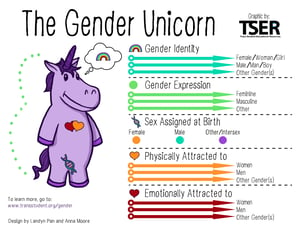Small is Beautiful: Education as if Every Student Really Mattered
In the small, beautiful, lakeside community of Burlington, there are both the advantages of a city — public transportation, rich cultural...

.jpg?width=667&height=457&name=orientation-2016_29607550361_o%20(1).jpg) In my work with high school students, the “pronoun question” comes up regularly. For some students, it is something they have never thought about before - some might even not remember what a pronoun is! For others, the pronoun you use when talking with them is something that matters deeply to them and signals either acceptance of their identity or rejection. Some students may still be struggling with their gender identity and not be certain how they want to be defined, and others may not fit neatly into the gender binary of the English language.
In my work with high school students, the “pronoun question” comes up regularly. For some students, it is something they have never thought about before - some might even not remember what a pronoun is! For others, the pronoun you use when talking with them is something that matters deeply to them and signals either acceptance of their identity or rejection. Some students may still be struggling with their gender identity and not be certain how they want to be defined, and others may not fit neatly into the gender binary of the English language.
Pronoun best practice
While working on writing a blog a few months ago, I had a conversation with a colleague about pronouns. My colleague said that, when referring to a single student, we should use he or she, while I asserted that using "they" as a singular pronoun is now widely acceptable and has been officially added to Merriam Webster! I prefer using the singular “they” because it is much easier than writing “he or she” repeatedly through an article. It streamlines the prose and makes it easier to read. Most importantly, using “they” is more inclusive and reflective of the gender spectrum that we experience in our student body.
This question is one of many that we are having in our school around language and inclusivity. So, what is the best way to address students’ various needs around pronouns? Here are a few ways to be inclusive with your pronouns:
Talk about the Spectrum of Gender Identity and Expression
 Recently, we hosted a workshop on Creating LGBTQ+ Inclusive Community Environments with Mara Iverson from Outright Vermont. Mara gave us some great tools to use when talking about gender, including the Gender Unicorn! The Gender Unicorn presents Gender Identity (personal sense of one's own gender) and Gender Expression (person's behavior, mannerisms, interests, and appearance that are associated with gender in a particular cultural context) as a scale. This gives a great visual representation of the spectrum of gender and helps represent how to get away from thinking of gender in binary terms.
Recently, we hosted a workshop on Creating LGBTQ+ Inclusive Community Environments with Mara Iverson from Outright Vermont. Mara gave us some great tools to use when talking about gender, including the Gender Unicorn! The Gender Unicorn presents Gender Identity (personal sense of one's own gender) and Gender Expression (person's behavior, mannerisms, interests, and appearance that are associated with gender in a particular cultural context) as a scale. This gives a great visual representation of the spectrum of gender and helps represent how to get away from thinking of gender in binary terms.
In addition to putting gender identity and expression on a spectrum, the gender unicorn helps visually represent sexual orientation as a spectrum and helps break down the idea that your gender expression necessarily correlates with who you find attractive. Finding ways to open up the discussion of gender identity and sexual orientation as different spectrums is very helpful in creating open and inclusive communities.
Changing the culture
Another way to change a school culture is by creating a Gay Straight Alliance group. A recent study demonstrated that simply having one of these groups in your high school can help students decrease depression, increase self-esteem, prevent drop-outs, and decrease substance abuse. The idea is that even if students are not part of the club, they know that their school is a safe and accepting place if the GSA exists.
We started a GSA club as a place where students could get support around issues of gender identity expression and sexual orientation. We provide a safe space for students to ask questions, get support and affirmation, and build community. Our students meet regularly with the GSA group from a nearby high school, which brings in even more perspectives. Additionally, our club has brought forth issues around acceptance and allyship to the larger community discussions we have in our weekly all-school meetings.
As a school, making small shifts around how we use pronouns supports our larger efforts to create a more inclusive environment. It can take some time to adjust to using language in a new way, but approaching the change with an open mind and being willing to ask questions will help. We have committed to creating a welcoming environment for all students. The way we use language is one way to demonstrate that we respect each other for who we are.
Editor's note: This post was originally published in February 2017 and was updated for accuracy and comprehensiveness in October 2019.

In the small, beautiful, lakeside community of Burlington, there are both the advantages of a city — public transportation, rich cultural...

Adolescence is a time of enormous growth and self-discovery. As teens navigate who they are, how they fit in, and what matters to them, they need...

“But what do you do in the winter?” is a question that I hear frequently from people outside Vermont when they learn about our small boarding and day...